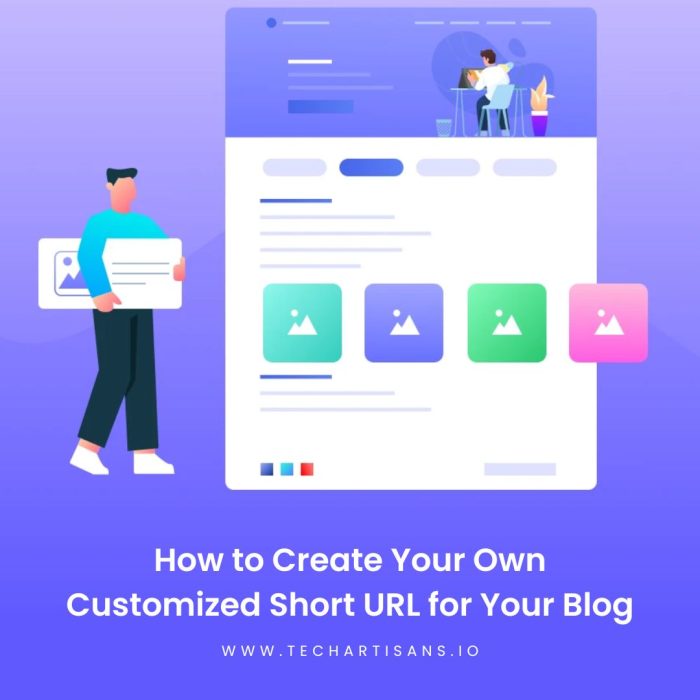In today’s digital era, a customized short URL for a blog isn’t just a convenience—it’s a branding powerhouse. Short URLs can significantly enhance your online visibility, making your brand more memorable and easier to share across various platforms. This guide outlines steps to create a unique short URL, enhancing your branding and content reach.
How to Create Your Own Customized Short URL for Your Blog
Making a special short URL for a blog is a smart move that can really help you get noticed online. For further insights, check out our guide on how to create your own customized short URL for your blog. This guide will show you, step by step, how to create a short and easy-to-remember link. Doing this will make your brand more visible, and more people will be able to find and enjoy your content.
Understanding URL Shorteners
URL shorteners are like tools that make long web links shorter and easier to remember. To learn more about these tools and their usage, explore our comprehensive guide on URL shorteners. They make it simple to share links in different places, and they can also show you how many people clicked on the link. This helps you understand how much people are interested in your content.
Benefits of URL Shortener for Businesses
URL shorteners offer several benefits for businesses. They enhance brand recognition with memorable links, Discover more about this topic in our article on the benefits of using agile methodology in business improve user experience by simplifying sharing, and provide valuable analytics for content strategy optimization.
Problem with Generic URL Shorteners
While URL shorteners undoubtedly bring a host of benefits to the table, resorting to a free generic URL shortener may seem appealing but has drawbacks. They lack branding and provide limited analytics. For more details, read our discussion on how to write great site links for Google ads. and raise security concerns, impacting trust and marketing effectiveness.
Limitations of Using Free URL Shorteners
Using free URL shorteners is useful, but they have some downsides. They usually don’t let you customize the link to match your brand. They do not provide detailed information on how many people clicked the link, making it hard to improve. Also, free short URLs can pose security risks because anyone can see and use them.
Importance of Having a Branded URL for Trust and Recognition
Having a branded URL is crucial for fostering trust and recognition among your audience. It not only instills a sense of professionalism but also reinforces your brand identity. More on this can be found in our article on brand awareness and its effective measurement each time your link is shared. This consistent visibility ultimately bolsters credibility and promotes brand recall.
Advantages of Creating Your Custom URL Shortener
Making your own special short web link comes with many benefits that go beyond just looking nice. It directly affects how people recognize your brand. For additional information, visit our guide on the latest web design trends. how users experience your content, and how you can keep track of data. Let’s explore these advantages in more detail.
Enhanced Brand Visibility
A custom short URL enhances brand visibility by providing instant recognition and shareability, driving increased traffic and broader brand awareness.
Control Over the Data and Analytics
A custom URL shortener provides valuable data insights. Learn more about this in our detailed post on how to set up Google Analytics including click-through rates, audience location, and engagement timing, enabling data-informed content strategy and business growth.
Cost-Effective in the Long Run
Custom URL shorteners may have initial costs, but they offer long-term benefits. They boost brand visibility, enhance click-through rates, and provide valuable analytics, leading to improved ROI and making the investment worthwhile.
Steps to Create Your Custom URL Shortener
Let’s explore how to create your custom URL shortener, simplifying the process for all, including those less tech-savvy. This guide will help boost your brand’s visibility and user experience.
Choosing and Registering a Short Domain
To create your custom URL shortener, start by choosing and registering a short domain. Our article on choosing the best blogging platform offers valuable insights in this area ideally echoing your brand. You can use platforms like GoDaddy or Namecheap for domain registration. After completing the process and payment, your short domain is good to go!
Selecting a URL Shortening Service
After registering your short domain, choose a URL shortening service. Options like Bitly, Rebrandly, and YOURLS offer unique features. Bitly provides reliability and analytics. Rebrandly focuses on URL customization and branding. YOURLS is a self-hosted, open-source option for full data control. Research to find the best fit for your business needs and budget.
Setting Up Hosting and Database
Setting up hosting is the next step in creating your custom URL shortener. Hosting services like Bluehost, SiteGround, or Hostinger provide reliable solutions with different plans. Afterward, establish a database, which stores data related to your shortened URLs. Options like MySQL or PostgreSQL are popular.
Integrating the Domain With the URL Shortening Service
To link your domain to your URL shortening service, follow our step-by-step guide on how to add a Pinterest button in WordPress, which covers similar integration techniques. Log into your service. Navigate to the ‘custom domains’ section. Enter your registered short domain. Verify domain ownership, typically by updating DNS records in your domain registrar’s dashboard, with the exact process varying based on your service and registrar.
Configuring and Customizing the Short URL Settings
The final step is to configure and customize your short URL settings. This includes defining the URL structure, setting up trackable UTM parameters, and customizing the back half of your URLs to align with campaigns or content themes, ultimately creating a unique and memorable URL for your blog.
Testing and Using the New Custom Short URL
Once your custom short URL is set up, it’s crucial to test it. Enter your new short URL into a web browser to ensure it redirects to the correct webpage. If it’s working correctly, start using it for your blog posts. Monitor your analytics to measure its effectiveness and make adjustments as necessary.
Tips for Choosing the Perfect Custom Short URL
Choosing the right custom short URL for a blog is crucial. It should be efficient, memorable, brand-aligned, and boost your online presence. For more tips on this topic, read our article on what makes for a badass website. Here are some tips to help you make the best choice.
Making it Memorable and Related to the Brand
Your custom short URL should be memorable and closely tied to your brand, enhancing recognition. Choose a concise, easy-to-pronounce URL that reflects your brand’s ethos or name. This approach ensures your custom URL is user-friendly and boosts brand visibility and recall.
Keeping It Short and Avoiding Complex Characters
A crucial aspect of a custom short URL is brevity. Short URLs are easier to remember and use. Avoid complex characters or symbols, and opt for simple alphanumeric characters for a straightforward, user-friendly experience.
Creative Use of Domain Extensions
Exploring unique domain extensions, such as .ly, .io, .ai, or industry-specific options like .tech, can enhance the uniqueness and relevance of your custom short URL. These extensions make your URL stand out and reinforce your brand’s identity or industry affiliation.
Potential Pitfalls and Considerations
Creating a custom short URL is a great idea for branding, but it comes with potential challenges. Consider factors like the upfront costs, security concerns, and the complexity of DNS configuration. Additionally, ensure your chosen URL is unique, brand-relevant, and user-friendly.
Regular Updates and Maintenance
Regular system updates are essential to keep your custom short URL system secure and performing well. These updates should cover your hosting software, database management systems, and URL-shortening platform. Neglecting updates can lead to security issues and poor performance, affecting user experience and brand reputation.
Ensuring Security and Preventing Misuse
Ensuring the security of your custom short URL is vital. Implement strong security measures, including encryption and regular security checks to prevent misuse for spam or phishing. Being proactive in identifying and addressing suspicious activity protects your brand’s integrity and user trust.
Handling Traffic and Server Loads
Efficiently managing server loads and traffic is crucial. As your site grows, more users access your custom short URLs, requiring additional server resources. Implement load balancing, upgrade your hosting plan, or consider using a Content Delivery Network (CDN) to ensure consistent and optimal performance
Integrating With Other Tools and Platforms
Establishing a custom short URL for blog is just the beginning. To maximize its impact, you should integrate it with various tools and platforms. This integration streamlines your operations, enhances marketing efforts, and improves user engagement.
Using URL Shorteners With Social Media Platforms
Integrating your custom short URL with social media platforms enhances your strategy by enabling you to share branded links in posts and track click-through rates. This approach improves user experience and provides valuable insights to optimize your social media tactics.
Integration with Marketing and Analytics Tools
Integrating your custom short URL with marketing and analytics tools allows for data-driven insights into your blog’s performance. Tracking click-through rates and conversions helps refine your marketing strategy and enhances your URL’s contribution to traffic and engagement.
Conclusion
Creating a custom short URL for a blog boosts branding and user experience. It enhances visibility, recall, and engagement insights. Start adopting a custom URL today to strengthen your online branding and improve your digital strategy. Remember, success lies in the details, including a simple, memorable blog URL.
FAQs
1. Is URL Shortening Safe?
Yes, URL shortening is safe. However, just like any online tool, it can be exploited by malicious actors to hide harmful links. Always ensure you only click on shortened URLs from trusted sources.
2. Does URL Shortening Affect SEO?
No, URL shortening does not negatively affect SEO. It can improve your SEO if the short URL is descriptive and relevant, as search engines can index it more effectively.
3. Can I Track Analytics With a Shortened URL?
Absolutely! Many URL shortening services offer built-in analytics features, allowing you to track click-through rates, user behavior, and more.
4. Are There Any Limits to How Many URLs I Can Shorten?
This depends on the URL-shortening service you use. Some services may have limits, especially on free plans. But with a paid plan, you typically create more, if not unlimited, shortened URLs.
5. Can a Shortened URL Expire?
Usually, a shortened URL does not expire and remains valid as long as the URL shortening service is operational and the linked webpage is active. However, some services may allow setting an expiration date if desired.
6. Can I Customize My Short URL?
Yes, many URL shortening services offer the option to customize your short URLs, which can enhance brand visibility and user experience. Remember to maintain a balance between brevity and descriptiveness.







